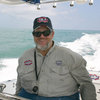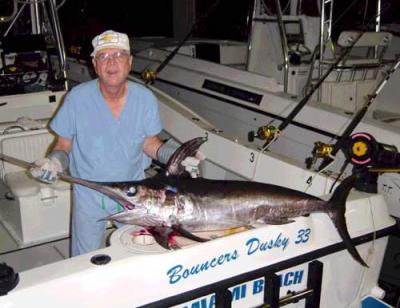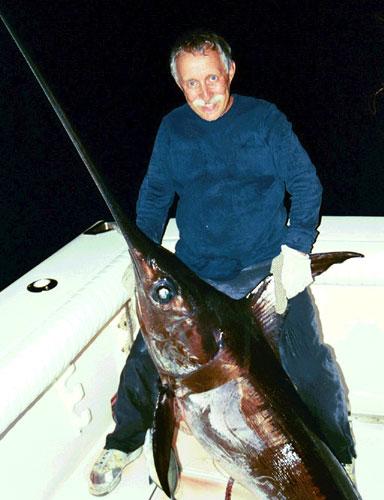The third bait went in the water just after 6. By 6:30 it was totally dark. The clock was ticking toward 7 when the reel started to talk. It was a slow but steady buzz as line walked off the reel. Joe pushed the drag lever up to strike and the reel screamed as line ripped into the water. The added pressure from the increased drag had pulled against the fish and it had panicked. Harvey and the captain hurried to clear the downriggers and other lines. Trophy swordfish caught off Miami Beach, FL.The glow of the red cyalume light stick could be seen running below the surface 100 yards behind the boat. Joe was on his way toward catching his first swordfish.
Joe had rode along with the captain on charters and had been the angler on research trips several times as he and the captain worked to perfect night swordfishing off south Florida. Joe was born with a very creative mind and his study of articles and comparison with other fishing methods brought him to believe that slow trolling with downriggers was the best way to catch these great gamefish. Now he was hooked up to the fruit of his labors.
Most boats drift for their swords. They put their baits out and drift across a variety of water depths as the wind and current carry them. By trolling, Joe reasoned that you could maintain your position relative to the wall of the drop-off and work your way into position to drift over key rises in the ocean floor. If you feel the fish are in 1200 feet of water, then why put your lines out in 1250 and soon find yourself in 1008 feet of water as you drift along the drop-off? The Gulf- stream current off south Florida runs north at 4 to 5 miles per hour, so with live baits out you are going north whether you drift or slow troll. At least with the trolling you can aim your spread over the most attractive bottom structure.
The bait pattern that Joe likes best so far (this is a learning program) is a live speedo, aka frigate bonita, on an 50 or 80 pound outfit spooled with one of the super braid lines and lighted with a red cyalume, fished 250 feet down on the port downrigger. He uses the same bait and tackle on the starboard downrigger, but uses a green cyalume. This downrigger is lowered to 125 feet. The third rod is rigged with a 12 ounce trolling lead at the top of his 20 foot wind on leader and lighted with a red "LP" battery operated light. This bait is about 200 feet behind the boat and rides about 100 feet down. The fourth rod is fish with no weigh on dark nights and 8 ounces on moonlit nights and has a green "LP" light ahead of the bait. If speedos are not available, Joe uses tinker mackerel or blue runners. If bait is scarce then rigged squid replace some or all of the baits.
The boat is run at about 1.5 to 2 mph and headed into the current adjusting slightly inshore or off to hit the best swordfish structures along the drop-off. The reels are fished with just enough drag to prevent line from slipping out as the spread is trolled. When the strike comes, the drag is advanced to the strike position. Due to the tender composition of swordfish, drags are fished with 11 or 12 pounds of drag at strike.
If you were trolling in the daytime, you would deploy a teaser or two behind the boat to attract fish. In the night you troll a large green florescent light behind the boat as your teaser. Check your baits at least once per hour. It is not very productive to troll empty hooks or dead and spinning baits.
Joe has his fish along side the boat in about 30 minutes. It is a spunky 75 pounder. The lead hook of Joe's double hook rig is securely in the corner of the fishes mouth and the trailer is hanging along the side of the fishes cheek. Photos are taken of the fish in the water next to the boat, the hook is slipped from the swords jaw while the bill is firmly in the grasp of the captain. The captain must use tough gloves for this task as the sides of a swordfishes bill can cut through loose weave materials like the rubber coated orange gloves so popular for lobstering and fishing.
Now high fives are pasted around. When Joe's fish struck, the first thing the captain did was hit the waypoint save on the GPS. The boat was then run back to a point 2 miles south of that saved waypoint. The baits were quickly reset and as the boat arrived on the saved position the deep line reel screamed with action. This is very common as swordfish will congregate socially or around schools of bait. One night Joe had 5 strikes on the same numbers.
It's Harvey's turn on the rod and it is soon obvious that this is a bigger fish. As the sliver of moon is setting in the west, Harvey has brought his fish to the boat in 45 minutes. In Harvey's case the trailer hook is set in the side of the fishes face, just behind the eye. It was time for more photos and then hook removal before the release. As the captain reached for the bill the sword slashed toward the captains face. It was a near miss. It was also a reminder that unlike sails and marlin, which may spear the careless crew member, Swordfish will slash you with lightning fast sideways swings of their bill. Safely released another "gladiator of the sea" returned into the depths in search of food.
This trip started at 6 PM from Miami Beach Marina, at the south end of Miami Beach, Florida and Joe and Harvey were back standing on the dock at 9:30. Not all swordfish trips are this good, but many will be as good or better. Some nights you just enjoy the peace and tranquility as your anticipation rises. This is the nature of big game fishing.
It must be mentioned that the National Marine Fisheries Service has done a great thing for the swordfish population. They have closed the area from Key West to the Carolinas to longlining in an effort to protect this juvenile swordfish hangout. This was done to preserve this declining fishery. It also reduces pressure on the shark, sailfish, marlin and tuna that swim in this area. We as recreational anglers or charter boat operators gain some great fishing action from this closure. But we must be conservation minded. We all may keep a fish from time to time for the dinner table, but let's not abuse this special fishing situation.
Swords Drawn - Swordfishing Off Miami Beach
Posted: 08/09/2007




